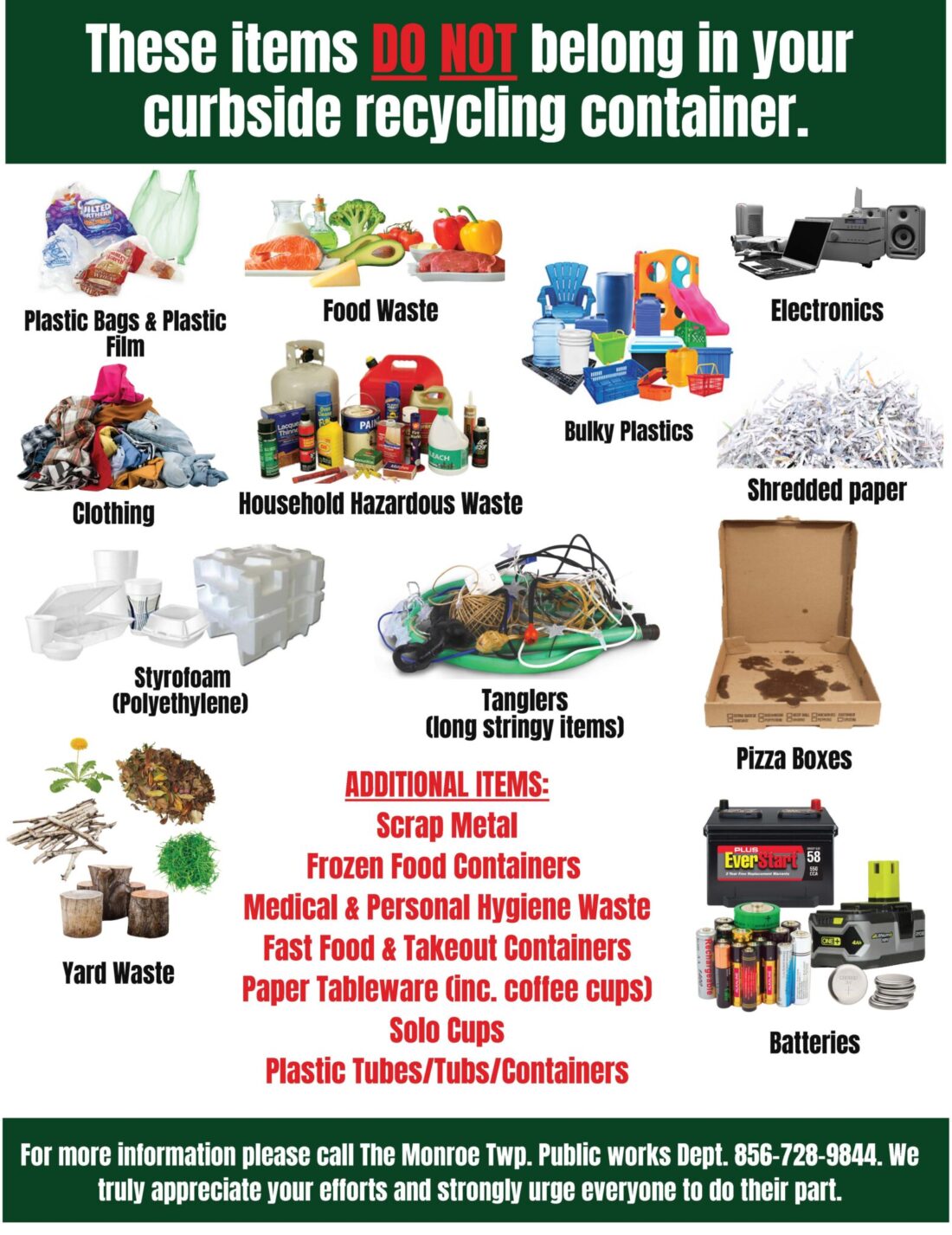Monroe Township residents can recycle accepted items together in one container. Items should be empty, clean and dry! DO NOT BAG RECYCLING, please keep items loose in container. Monroe Township sanitation Department may flag your container and refuse pickup if there are plastic bags or contamination present.
PLASTICS
#1-2 BOTTLES AND JARS ONLY where necks are smaller than the base
No food or liquid residue (Clean & Dry)! Please remove caps and lids! Examples:
Water/Soda/Juice bottles
Milk Jugs
Shampoo Bottles
Laundry Detergent Jugs
Ketchup Bottle
GLASS
Clean & Dry: Glass Bottles/Containers/Jars – lids and caps removed (if metal, recycle separately)
PAPER | CARDBOARD | CARTONS
Printer Paper
Envelopes (with or without windows)
Cereal Boxes
Junk Mail
Magazines/ Newspapers
Telephone Books
Cardboard (corrugated must be flattened and tied with twine)
METALS
Aluminum/Steel/Tin cans and lids (Clean & Dry)
DO NOT Recycle The Following Items:
Aluminum Foil
Batteries
Broken Glass
Bubble Wrap
Caps/Lids
Cellophane
Ceramics
Clam-shell containers
Electronics
Frozen Food Boxes
Food Residue
Glassware
Hardback Books
Hazardous Waste
Large Rigid Plastics
Light Bulbs
Liquids
Medicine
Mirrors
Needles
Paper Towels/Napkins/Plates/Cups
Plastic Bags (return to stores)
Plastic cups, utensils, plates, straws
Plastics other than #1-2 or Plastics without smaller necks
Pizza Boxes
Pots/Pans
Rigid Plastics (Laundry Baskets, Toys, Lawn Chairs)
Scrap Metal
Shredded Paper
Sharps
Styrofoam
Syringes/Needles
Tangly Items like Hoses/Cords
Tire Rims/Car Parts
Tissues
Toys
Vases
Waxed Paper
Wet Paper/Cardboard
Wire Clothes Hangers
Wrapping Paper
Yard Debris
Reasons for Program Changes:
NO Plastics #3-7 – Monroe Township only accepts plastics #1-2 where necks are smaller than the base. This includes clean, empty and dry plastic bottles, laundry detergent bottles, ketchup bottles, and milk jugs.
These changes reflect the “wish-list” of manufacturers who purchase recycled material. Much of this manufacturing takes place in China where there has been a widespread crackdown on contamination of recycling bales entering the country.
The growth of single-use plastics has also increased the number of plastic items entering the recycling stream, and all plastics are not created equally. These items have different chemical makeups, even those with the same recycling number!
The #1 and #2 plastic jugs, bottles and containers with smaller necks is the best description for what manufacturers are seeking, which is plastic items made with Natural HDPE or Colored/Pigmented HDPE.
NO Wrapping Paper or Tissue Paper – Many types of wrapping paper now include metallic or glitter items that contaminate the stream. Many are also filled with flame retardant chemicals. Because there is a great likelihood that residents will have embellished wrapping paper, we ask that residents please keep it out of their stream.
NO Shredded Paper – The paper is too small to be processed by recycling sorting facilities. Bags of shredded paper often become torn or damaged during collection, releasing small pieces of paper which cannot be separated for recycling. Shredded paper should be placed curbside with bulk pick up.
NO Pizza Boxes – Water, grease and other residue degrades the value of paper. Most pizza boxes are covered in grease and contaminate the cardboard.
NO Paint Cans – Most paint cans have paint still in them which contaminates other recyclable material.
NO Aerosol Cans – Aerosol cans are marked a danger to recycling sorting facilities.
NO PET Clam-shell Containers – Clam-shell containers are different from plastic bottles because the two use different formulations of plastic that melt at different temperatures, making it hard for manufacturers to reuse this material. They are also likely to be contaminated with food waste.
Plastic Drip Tape – Both foreign and domestic markets for this material have ended.
NO Photo Paper/Photos – Most print-at-home photo paper has a coating of plastic that makes it different than regular paper.
For actual photos: photography processing is a chemically-intensive operation that involves a whole host of ingredients, from acetic acid to gelatin. Some of these photographic chemicals remain in the paper of the resulting photographs — posing challenges to recyclers.
NO Single-Use Coffee Cups* – Most single-use cups are lined with a fine film of polyethylene, which protects the cups from the liquid inside. It is difficult and expensive to reprocess (because the materials must be separated). Styrofoam coffee cups are not accepted either.
NO Frozen Food Boxes & Refrigerated Gable-Top Containers (AKA-Wax Coated)* – If it comes from the freezer, it should go in the trash. Frozen-food boxes are lined with plastic on the inside that protects the food from getting freezer-burnt or wet.



